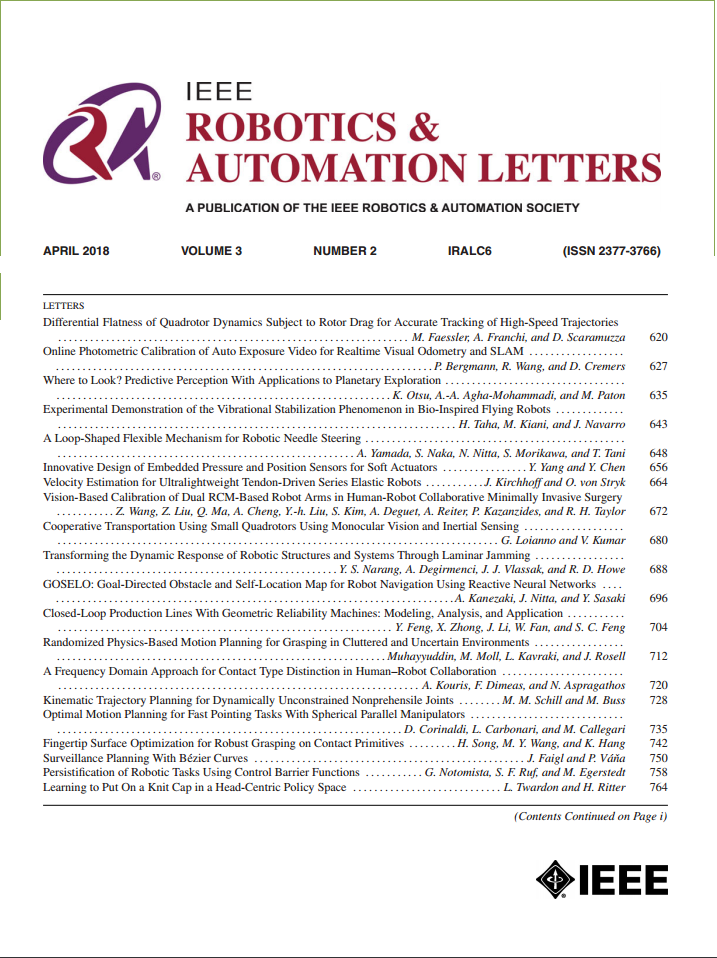具有气动驱动可变刚度单元的便携式上肢外骨骼,用于固定头顶和前方姿势的长期工作
IF 4.6
2区 计算机科学
Q2 ROBOTICS
引用次数: 0
摘要
长期以固定的姿势工作往往会导致肌肉疲劳和肌肉骨骼疾病。现有的被动外骨骼用于头顶任务,在手臂下降过程中会产生阻力,而主动外骨骼由于其重量和缺乏舒适性而面临局限性。为了解决这些挑战,本研究介绍了三种气动驱动变刚度单元的设计:弯曲执行器、拉伸执行器和齿啮合离合器。在此基础上,开发了一种便携式半主动上肢外骨骼,用于持续的头顶和前方姿势。外骨骼由一个便携式气动系统控制,总质量为3.35公斤。通过性能评估结果验证了将变刚度单元应用于外骨骼设计的可行性,例如,弯曲变刚度执行器在相对较低的真空压力40 kPa下实现了50.98 nm /rad的弯曲刚度和87.9倍的刚度变化率。与不佩戴外骨骼的情况相比,12名健康受试者在保持4种常用装配姿势的情况下,平均肌肉激活水平降低了42.3±2.4%,这表明该外骨骼有望用于固定架式和前方姿势的长期工作辅助。本文章由计算机程序翻译,如有差异,请以英文原文为准。
A Portable Upper-Limb Exoskeleton With Pneumatic-Driven Variable-Stiffness Units for Long-Term Working in Fixed Overhead and Ahead Postures
Long-term working in fixed postures often leads to muscle fatigue and musculoskeletal disorders. Existing passive exoskeletons for overhead tasks introduce resistance during arm lowering, while active exoskeletons face limitations due to their weight and lack of comfort. To address these challenges, this study introduces the design of three pneumatic-driven variable-stiffness units: a bending actuator, a tensile actuator, and a teeth-engagement clutch. Based on them, a portable semi-active upper-limb exoskeleton was developed for sustained overhead and ahead postures. The exoskeleton is controlled by a portable pneumatic system and the total mass is 3.35 kg. Feasibility of applying the proposed variable-stiffness units in exoskeleton design was verified by promising results of performance evaluation, e.g., the bending variable-stiffness actuator achieved 50.98-Nm/rad bending stiffness and 87.9-fold stiffness variation ratio at a relatively low vacuum pressure of 40 kPa. Compared to the condition without wearing the exoskeleton, averaged muscular activation level reduced by 42.3 ± 2.4% over twelve healthy subjects while maintaining 4 commonly-used postures in assembly work, indicating the promise of applying the proposed exoskeleton for long-term working assistance in fixed overhead and ahead postures.
求助全文
通过发布文献求助,成功后即可免费获取论文全文。
去求助
来源期刊

IEEE Robotics and Automation Letters
Computer Science-Computer Science Applications
CiteScore
9.60
自引率
15.40%
发文量
1428
期刊介绍:
The scope of this journal is to publish peer-reviewed articles that provide a timely and concise account of innovative research ideas and application results, reporting significant theoretical findings and application case studies in areas of robotics and automation.
 求助内容:
求助内容: 应助结果提醒方式:
应助结果提醒方式:


